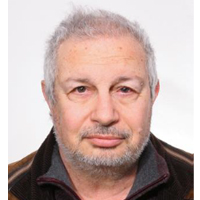Effects of Fast-Walking on Muscle Activation in Young Adults and Elderly Persons
Published on: 20th January, 2017
OCLC Number/Unique Identifier: 7286424597
Coactivation of agonist and antagonist muscles participates in the regulation of joint stiffness and postural instability. Alterations on muscle activity have been revealed as an important falling risk factor. It is unclear the effects, and age-related differences, of a prolonged demanding task on the muscular coactivation levels. We compared muscle activation amplitude and coactivation of the vastus medialis, biceps femoris, tibialis anterior, and gastrocnemius medialis from surface EMG in 16 young adults (age 21-33) and 8 elderly adults (age 66-72) while fast-walking at 70% of their maximum heart rate. Overall, the elderly demonstrated higher coactivation indexes than the young individuals. Ankle coactivation decreased in the first half of the swing phase, while coactivation at the knee increased in the latter half of the swing phase in our elders. Alterations of muscle activation and coactivation on the knee and ankle were more prominent close to landing and in the swing phase. Our results suggest that these alterations may suggest potential concerns with respect to the risk of falls.
Kinematics and Electromyographic Analysis of Gait with Different Footwear
Published on: 24th January, 2017
OCLC Number/Unique Identifier: 7317654943
Kinematic analysis and surface electromyography are tools being used as important methods to evaluate the human gait and to analyze different types of footwear aiming modifications and adaptations to the human locomotor system, especially of the feet. The aim of the present study was to analyze through electromyography (EMG) the muscles tibialis anterior (TA) and gastrocnemius lateralis (GL) and gastrocnemius medialis (GM) and to capture digital images of the human gait in four different footware situations, barefoot with tennis, platform shoes and high heels. Twenty healthy women with a mean age of 22.6 years took part in this experiment, which was performed on a treadmill at a speed of 3.8 m/s. The results showed that shoes that do not allow a normal movement of the tarsal bones caused changes in the trajectory of the gait, which promotes a greater muscular movement. This study concluded that shoes closer to a normal position and allow greater mobility of the feet, decrease muscular demands, which in everyday situations cause less localized muscular fatigue.
Effect of Lower Extremity Training in Diabetic Peripheral Neuropathy
Published on: 12th February, 2024
Background: Diabetic peripheral neuropathy is a symmetrical length-dependent sensorimotor polyneuropathy due to chronic hyperglycemia. The World Health Organization (WHO) identified diabetes as a major global health concern. Diabetic neuropathy is characterized by motor dysfunctions (weakness and atrophy) especially at the distal muscles of lower limbs, and impaired dynamic muscular control in type 2 diabetes patients. Symptoms start in a distal-to proximal pattern in the feet, and ankle and proximally in the hip and knee for both flexors and extensors. Proximal muscle weakness affects postural stability. Dorsiflexor weakness causes increased hip, knee flexion and metatarsophalangeal extension in the initial swing whereas weakness in plantar flexors causes a greater amount of hip and knee flexion during the stance phase.Methodology: 34 subjects with Diabetic Peripheral Neuropathy who fulfilled all the inclusion criteria were recruited for the study. Ethical standards have been maintained and informed consent was taken. Subjects were randomly assigned by lottery method into two groups, intervention, and control with 17 in each. Since it is a single blinded study subjects were blinded about the interventions provided. Pre and post-test scores were taken before and after 4 weeks using Surface Electromyography (sEMG), Kinovea Software, Functional Gait Assessment (FGA) and Short Form -36 (SF-36).Results: The pre and post-score values of the kinematics of gait, Functional Gait Assessment, and Short Form - 36 were analyzed using a Paired t-test and Wilcoxon Signed Rank test within the group analysis, Mann- Whitney U test and Independent t-test for between the group analysis. Both groups displayed notable variations, whereas the intervention group exhibited more significant differences (p < 0.05). Thus, it can be inferred that lower extremity training significantly improves gait kinematics and quality of life in diabetic neuropathy.Conclusion: Lower extremity training is effective in improving the kinematics of gait and quality of life in diabetic neuropathy.




